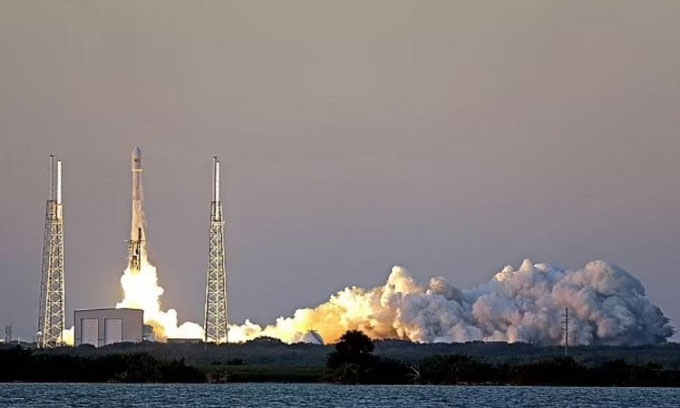Astronomers predict that the Falcon 9 rocket from SpaceX, launched into space nearly 7 years ago, is on a collision course with the Moon in early March this year.
The Falcon 9 rocket’s upper stage has been drifting in orbit since SpaceX launched the weather satellite in 2015. After firing its engine to reach a transfer orbit, the rocket’s second stage became obsolete as the Deep Space Climate Observatory began its journey to the Earth-Sun Lagrange Point. The launch vehicle is at such a high altitude that it lacks sufficient fuel to re-enter the atmosphere and does not have enough energy to escape the gravitational pull of the Earth-Moon system.

The Falcon 9 rocket carrying the Deep Space Climate Observatory into space in 2015. (Photo: AP)
Currently, experts indicate that the trajectory of the used rocket will intersect with the Moon on March 4. In early January, Bill Gray, an expert tracking near-Earth objects like asteroids and comets, called on both amateur and professional astronomers to monitor the rocket. With new data, Gray suggests that the upper stage of the Falcon 9 will definitely crash into the dark side of the Moon, near the equator, although it is very difficult to predict the exact impact of sunlight on the rocket and how it may alter the vehicle’s trajectory.
“The unpredictable impacts are very small,” Gray said. “But they will gradually accumulate from now until March 4. Space debris can be somewhat difficult to track.” Gray emphasized the need for further observations to determine the exact timing and location of the impact.
If the predictions are accurate, satellites orbiting the Moon, including the Lunar Reconnaissance Orbiter and India’s Chandrayaan-2, may collect observations of the impact crater. In 2009, NASA intentionally crashed a used rocket stage into the Moon. However, the upcoming collision will mark the first time a piece of hardware accidentally strikes the lunar surface.
In interplanetary missions, the upper stage of the rocket is usually sent to a heliocentric orbit to move away from Earth and the Moon. For missions involving spacecraft flying close to Earth, this component typically falls back into the atmosphere and burns up. The second stage of the Falcon 9 weighs approximately 4 tons and is expected to slam into the Moon at a speed of 2.58 km/s. The Falcon 9 rocket launched the Deep Space Climate Observatory (DSCOVR) from Cape Canaveral Space Force Station in Florida in February 2015 during a mission worth $340 million.


















































